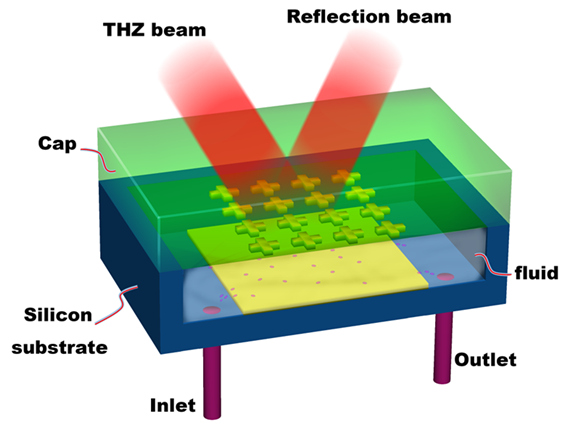
Refractive index sensing is one of the representative techniques for biochemical sensing applications. Recently, terahertz (THz) sensing technique has attracted extensive attention because the THz fingerprints of bio-molecules and chemical substances could greatly improve the sensitivity for detection and sensing. Most THz sensors rely on electromagnetic resonant structure so far with strong field confinement such as metamaterials. However, the sensitivity is limited due to the long wavelength of THz wave and the evanescent wave sensing mechanism.
A novel refractive index sensor design based on the integration of microfluidic channel into metamaterial absorber is proposed by Professor CHEN Qin's research group at Suzhou Institute of Nano-Tech and Nano-Bionics (SINANO) of Chinese Academy of Sciences. Based on resonant field rather than the usual evanescent wave, sensitivity as high as 3.5 THz/RIU can be achieved in the frequency range of 4-9 THz. This study was published in Laser & Photonics Reviews.
Metamaterial absorber, a metal microstructure/dielectric/metal film stacked structure, is an artificial electromagnetic composite material that can trap the incident light. Microfluidic channels are placed on top of metamaterial absorber, . Therefore, the spatial overlap between the localized field and the analyte in the channel is small, which limits the sensitivity.
Researchers developed a special packaged sensor by integrating microfluidic channel into metamaterial absorber. The intermediate hollow layer of metamaterial absorber has dual functions, i.e. the dielectric layer of absorber and the microfluidic channel. Large spatial overlap between liquid analytes in the channel and highly confined local resonant modes can be achieved. Consequently, the sensitivity, defined as resonant peak shift with refractive index changes, is greatly improved due to the enhancement of THz waves-matter interaction.
The results agree well with the design. Compared to optical sensing techniques based on evanescent waves, the corresponding performance increases remarkably. The fabrication process of the proposed sensor is simple with standard low-cost fabrication techniques and therefore it has a wide range of applications.
This mechanism and the device design based on localized resonant mode are not limited to THz waves. It can also be extended to visible and near-infrared region, which boosts the optical refractive index sensing techniques into the applications of biochemical detection and material analysis.

Figure: The schematic of metamaterial absorber integrated microfluidic sensor. (Image by SINANO)

86-10-68597521 (day)
86-10-68597289 (night)

86-10-68511095 (day)
86-10-68512458 (night)

cas_en@cas.cn

52 Sanlihe Rd., Xicheng District,
Beijing, China (100864)

